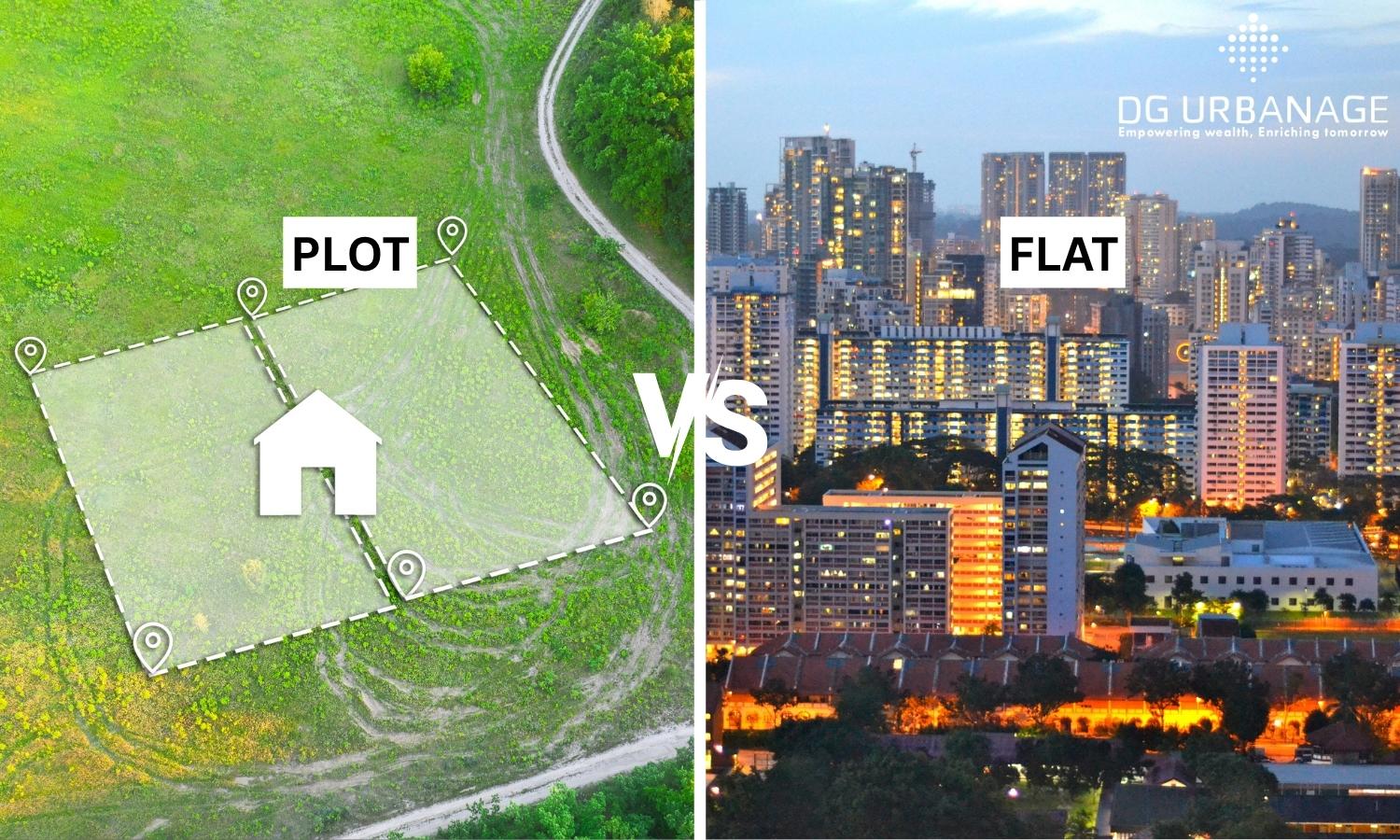
Flat or Plot: Which Gives Better Returns? A Buyer’s Guide [2025]
Choosing between a flat and a plot involves more than just budget—it's about aligning your decision with your lifestyle, long-term plans, and personal preferences. While both options offer unique benefits, understanding the key differences can help you make a more informed choice.
A flat is a ready-to-move-in unit within a multi-storey building. It offers convenience, modern amenities, enhanced security, and better connectivity—ideal for those who prefer a hassle-free living experience in prime locations.
On the other hand, a plot is a piece of land that provides the freedom to build a home exactly the way you envision it. It gives you complete ownership, design flexibility, and often, higher appreciation potential over time.
Ultimately, the decision rests on what you value more—customization and long-term investment (plot) or convenience and community living (flat).
What Are Flats and Plots?
Flat: Ready-to-Generate Rental Income with Minimal Effort
A flat, also known as an apartment, is a self-contained residential unit within a multi-storey building or gated community. When you invest in a flat, you gain ownership of your individual unit along with shared access to common areas like lobbies, lifts, and recreational spaces. These properties are usually ready-to-move-in and come with pre-designed layouts, offering convenience but limited structural flexibility.
Flats are an excellent choice for investors looking for immediate rental income. Modern housing societies offer attractive amenities such as landscaped gardens, fitness centers, swimming pools, clubhouses, and 24/7 security—all of which significantly boost rental appeal. Additionally, maintenance responsibilities are typically handled by the society, making flats a low-maintenance and hassle-free investment. If you aim for consistent cash flow with minimal involvement, a flat is a practical and popular option in today’s urban real estate market.
Plot: High Growth Potential and Complete Customization
A plot refers to a piece of undeveloped residential land where the buyer holds full ownership rights. Unlike flats, plots come with no predefined structure, offering complete flexibility to design and construct as per personal or architectural preferences. This "blank canvas" nature makes plots ideal for those looking to build a dream home or commercial space tailored to their needs.
From an investment perspective, plots generally do not provide immediate returns, as they generate no income until construction is completed. However, they offer significant long-term capital appreciation, particularly in fast-developing locations where land is becoming increasingly scarce. With full control over construction, lower initial maintenance, and faster appreciation potential, plots are suited for investors with a long-term horizon and higher risk tolerance.
Ownership and Legal Aspects in Flat vs Plot
1. Nature of Ownership in a Flat
When you purchase a flat, you own a specific unit within a larger residential complex. This includes shared access to common areas like hallways, elevators, staircases, and parking. The type of ownership can be either leasehold or freehold:
-
Leasehold: You have the right to occupy and use the property for a specified period, typically long-term, but you don’t own the land it stands on.
-
Freehold: You gain full ownership of both the flat and the share of land it’s built on, with no time limitations.
Legal Aspects to Consider While Buying a Flat:
-
Review the leasehold or freehold agreement carefully.
-
Verify the title deeds to ensure clear ownership.
-
Check for land-use approvals and legal clearances.
-
Ensure the property has a valid occupancy certificate.
-
Understand the maintenance charges and shared responsibility for common amenities.
2. Nature of Ownership in a Plot
Buying a plot offers complete ownership of the land as well as any structure built on it. It gives you the freedom to design and construct a home based on your personal preferences and requirements.
However, understanding local regulations is crucial, as land ownership is subject to specific laws and zoning norms depending on the region. These may include:
-
Land-use classifications (residential, commercial, agricultural, etc.)
-
Building regulations and permissible construction limits
-
Zoning laws and development control rules
Legal Aspects to Consider While Buying a Plot
-
Verify Title Deeds and Sale Deeds: Ensure the seller has clear ownership and the right to sell the land.
-
Check Land Survey Records: Confirm the exact boundaries and dimensions of the plot through official survey documents.
-
Review Land-Use Certificates: Make sure the land is approved for the intended use (residential, commercial, etc.).
-
Consult Legal Experts: Seek professional legal advice to identify any hidden disputes, encumbrances, or regulatory issues.
Being well-informed about land ownership laws, zoning regulations, and required documentation empowers buyers to make confident and legally sound decisions when investing in a plot.
Investment Considerations: Flat vs. Plot
What You Need to Know Before You Invest
Investing in a Flat
Flats are a popular real estate investment option, especially in urban areas where space is limited and demand for ready-to-move-in housing is high. However, to make a profitable investment, it's essential to evaluate various factors that influence a flat's long-term value.
Key Factors to Consider:
-
Market Trends: Study current real estate trends to identify price movements and emerging opportunities.
-
Demand-Supply Dynamics: Understand whether the area has a high rental demand or an oversupply of units.
-
Location & Connectivity: Invest in regions with strong infrastructure, good connectivity, and social amenities.
-
Growth Potential: Look for areas undergoing rapid development or urban expansion.
-
Rental Income: Assess the rental yield and occupancy rate in the target location.
A flat's value depends heavily on its location, infrastructure, and surrounding neighborhood. By aligning your investment with market insights and future development plans, you can maximize returns through both capital appreciation and steady rental income.
Investment Considerations in a Plot
Plots are often regarded as high-growth assets in real estate due to their limited availability and long-term value appreciation. Unlike flats, plot investments are not affected by the age or physical condition of a structure, making them a more stable option in terms of asset longevity.
Why Plots Offer Strong Investment Potential:
Real estate experts note that plots tend to appreciate faster than flats, primarily due to their scarcity and increasing demand. Their value is largely driven by location, infrastructure development, and connectivity to key urban centers. As cities expand, well-located plots near major projects or transit routes often see significant capital appreciation over time.
Key Factors to Consider When Investing in a Plot:
-
Location: Choose plots in areas with growth potential and planned infrastructure.
-
Proximity to Key Amenities: Ensure access to roads, public transport, markets, schools, and healthcare facilities.
-
Development Potential: Assess the land’s topography, soil quality, and zoning regulations to determine its suitability for construction.
Cost Analysis for Flat vs. Plot
Cost Dynamics of Flat Ownership:
The purchase cost of a flat includes not just the actual price but also several additional charges like registration fees, stamp duty, and legal expenses. Including these costs gives a clearer picture of the total investment.
Monthly maintenance charges are another important factor. These recurring costs should be added to your budget to assess the true affordability of owning a flat.
There are also hidden expenses that buyers should be aware of, such as unexpected maintenance or repair work, property tax, and insurance charges.
Cost Dynamics of Plot Ownership:
Before purchasing a plot, it's essential to conduct a thorough cost analysis to understand the total financial commitment. This includes the base price of the land along with related charges such as stamp duty, registration fees, and development costs.
Expenses for preparing the land for construction—like land clearing, grading, and building basic infrastructure—should also be included in the overall budget.
Long-term costs such as property taxes, maintenance expenses, and any applicable homeowner’s association fees must be considered for accurate financial planning.
Being aware of these expenses helps buyers make well-informed decisions aligned with their development goals for the plot.
Summary of the Difference Between Flat vs. Plot
Flats offer ready-to-move-in convenience, enhanced security, and access to shared amenities, making them ideal for those seeking a hassle-free lifestyle. On the other hand, plots offer greater flexibility for customized construction and often yield higher long-term appreciation, though they require more individual effort in terms of planning, development, and maintenance.
To quickly understand the key differences, consider the following points:
| Parameter | Plot | Flat |
| Cost | Generally lower initial cost | Higher initial cost, inclusive of amenities |
| Regular Income | Limited options for generating income | Potential for rental income |
| Value Appreciation | Potential for higher appreciation | Appreciation may be comparatively lower |
| Bank Loans | More Challenging | Easier access to home loans |
| Value of Money | Potential for better long-term returns | Immediate utility and comfort |
| Tax Benefits | Limited tax benefits | Eligible for various tax deductions |
| Construction Quality | Depends on individual development | Consistent quality in multi-unit buildings |
| Legal Verification | Crucial due diligence required | Typically, well-verified by developers |
| Flexibility | More freedom in design and construction | Limited customisation options |
| Security | May require additional security measures | Inbuilt security features in apartment complexes |
| Amenities | Limited or dependent on local facilities | Shared amenities within the complex |
| Convenience | May require self-management of services | Centralized management and services |
| Risk | Dependent on market trends and locality | Lesser risk due to shared responsibilities |





